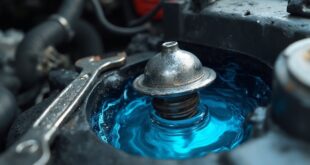Your gas gauge might be inaccurate or not working due to a few common issues. A defective sending unit, worn contacts, or faulty wiring can disrupt signals. Loose connections can also affect the gauge's functionality. If you find your gauge fluctuating, it may be stuck, or a blown fuse could be the culprit. Understanding these problems can help you troubleshoot. There's a lot more to explore about ensuring your fuel gauge functions reliably.
Causes of Gas Gauge Inaccuracy
When your gas gauge starts acting up, it can be frustrating, especially if you rely on it to monitor fuel levels. Several factors could cause inaccuracy.
A defective sending unit may be the culprit, as worn contacts can lead to incorrect readings. Circuit issues, like faulty wiring or loose connections, can disrupt the voltage supply, throwing off the gauge's accuracy.
Finally, a malfunctioning instrument cluster in newer cars can affect gauge functionality. Paying attention to these potential problems can help you diagnose the issue and guarantee your gauge reflects the true fuel level in your tank.
Components of the Fuel Gauge System
Understanding the components of the fuel gauge system is essential for diagnosing any issues you might encounter. Here are the key parts:
- Sending Unit: This sensor measures the fuel level and sends the information to the gauge.
- Fuel Gauge: The instrument in your dashboard displays the fuel level based on the sending unit's data.
- Wiring and Connections: Proper wiring is vital; any faults can disrupt the signal between the sending unit and the gauge.
- Fuse: The system relies on a fuse, which protects against electrical issues; a blown fuse can cause the gauge to fail.
Troubleshooting Fuel Gauge Issues
Although troubleshooting fuel gauge issues can seem intimidating, you can often address common problems with a few simple steps.
Start by filling your tank; this can sometimes dislodge a stuck fuel gauge floater. If that doesn't work, try gently tapping the gauge to see if it restores functionality.
Check the fuse related to your fuel gauge, as a blown fuse can lead to inaccuracies. If problems persist, consider seeking professional help for advanced diagnostics.
Regular maintenance can also prevent issues, ensuring your fuel gauge remains accurate and functional for your driving needs.
Calibrating Your Fuel Gauge
Calibrating your fuel gauge can be a straightforward process that guarantees accurate readings and helps you avoid running out of gas unexpectedly.
To get started, follow these steps:
- Check the Fuse: Verify the fuel gauge fuse is intact; replace it if blown.
- Inspect Wiring: Look for loose or corroded connections in the wiring.
- Test the Sending Unit: Use a multimeter to check the sending unit's resistance.
- Adjust the Gauge: If necessary, adjust the gauge using resistors to match the sender's output.
With these steps, you'll ascertain your fuel gauge provides reliable information about your tank's status.
Alternative Methods to Check Fuel Levels
How can you check your fuel level when your gauge isn't working?
You can start by removing the tank cap for a visual inspection of the fuel. If you have a flexible hose, use it as a dipstick to measure the fuel depth.
Track your mileage after refueling to estimate how much fuel you have left. Additionally, listen for sloshing sounds in the tank, which can indicate fuel presence.
If you want a more precise method, weigh your vehicle; this can give you an accurate idea of the fuel weight and remaining capacity.
Understanding Fuel Gauge Indicators
Ever wondered what those letters on your fuel gauge really mean? Understanding these indicators is essential for effective fuel management.
Here's a quick breakdown:
- F – Full: Your tank is topped off.
- E – Empty: Time to refuel soon!
- 1/4 – Quarter: You've got just a bit left.
- 1/2 – Half: You're halfway through your tank.
Depending on your vehicle, there may be additional markings, but these basics help you keep track of your fuel level.
Knowing these can prevent unexpected stops at the gas station and help you plan your trips better.
Preventative Maintenance for Fuel Gauges
Understanding your fuel gauge indicators is just the first step in maintaining your vehicle's fuel system.
To prevent issues, regularly check the fuse related to your fuel gauge. If it's blown, replace it to restore functionality.
Keep an eye on your wiring for corrosion or loose connections, especially near the fuel pump module. Additionally, avoid letting your fuel level drop too low, as this can damage the sending unit over time.
Performing routine inspections and addressing any abnormalities can help you catch problems early, ensuring your fuel gauge remains accurate and reliable throughout your vehicle's lifespan.
Frequently Asked Questions
Can Extreme Temperatures Affect My Gas Gauge Accuracy?
Yes, extreme temperatures can affect your gas gauge accuracy. High heat or severe cold may cause expansion or contraction in components, leading to inaccurate readings. It's crucial to monitor your fuel levels regularly under such conditions.
How Often Should I Check My Fuel Gauge Functionality?
You should check your fuel gauge functionality regularly, especially before long trips. Make it a habit to monitor it each time you refuel. This helps you identify any discrepancies early and guarantees reliable fuel readings.
Are There Any Warning Signs of a Failing Fuel Gauge?
You might notice your fuel gauge fluctuating unexpectedly or remaining stuck. If it shows empty despite a full tank or fluctuates erratically, these are warning signs indicating your fuel gauge may be failing.
Do Different Fuel Types Impact Gauge Readings?
Different fuel types generally don't impact gauge readings directly, but variations in fuel density can affect accuracy. If you're using alternative fuels, check compatibility with your vehicle to guarantee the gauge performs at its best.
What Tools Do I Need for Basic Fuel Gauge Maintenance?
For basic fuel gauge maintenance, you'll need a multimeter to check electrical connections, a fuse puller for inspecting fuses, and basic hand tools like screwdrivers and wrenches for accessing the gauge and sender unit.
 Car Service Land Coupons for Oil change, Tires, Wheel alignment, Brakes, Maintenance
Car Service Land Coupons for Oil change, Tires, Wheel alignment, Brakes, Maintenance




